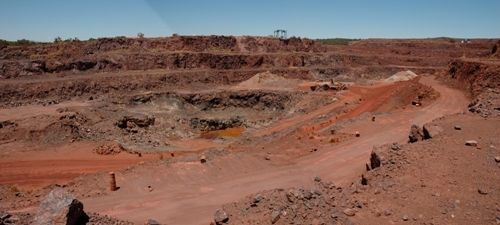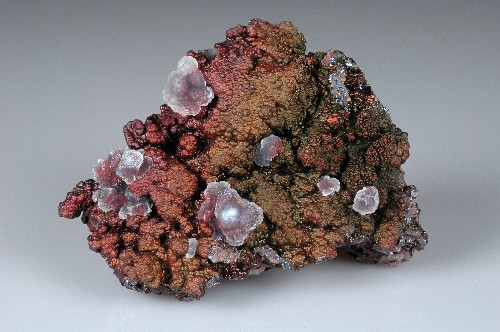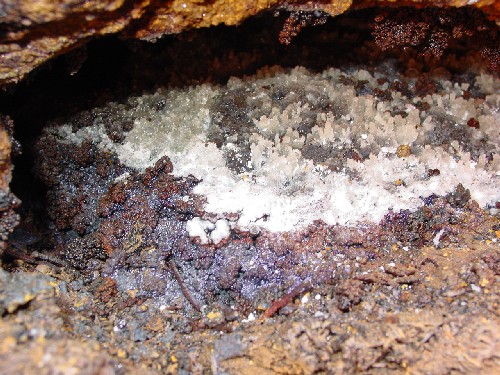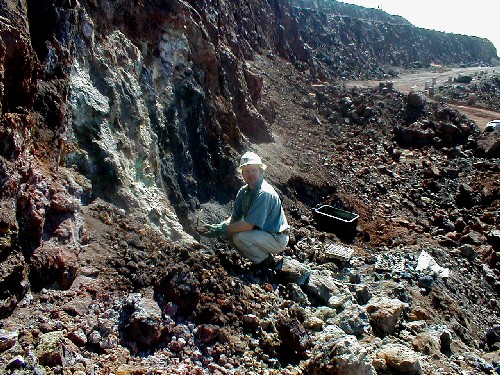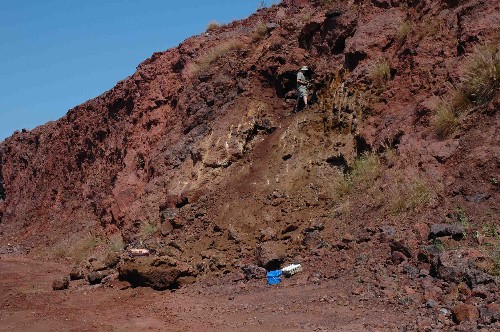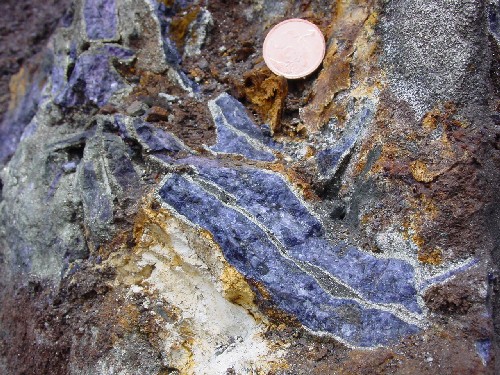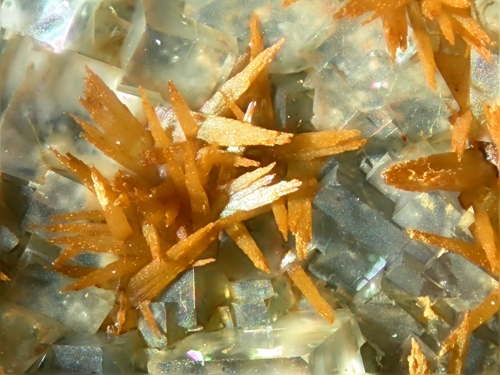|
|
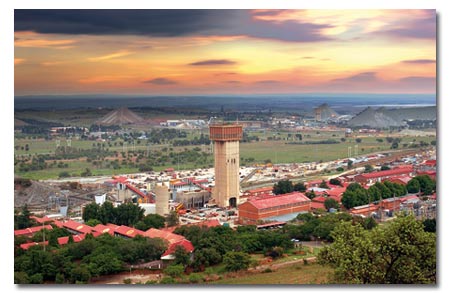
Vue générale de l'exploitation
![]()
Vergenoeg
Fluorspar Mine Site name
Vergenoeg Fluorspar Mine |
Vue de la mine en Janvier 2007
|
Fluorite sur Goethite |
a 30cm vug lined with stalictitic transluscent fluorite which is on iridesccent goethite |
![]()
MIXED
FORTUNES FOR FLUORSPAR
South Africa has about 10% of the world’s fluorspar reserves, but
its two principal producers have been experiencing mixed fortunes. Early
in 2007, the Spain’s Minerales y Productos Derivados SA (Europe’s
largest fluorspar user), invested R100 million in South African mining
junior Metorex Ltd and it is providing technical assistance for its Vergenoeg
fluorspar mine.
Metorex has been involved in a study into the possibility of establishing
an aluminium fluoride plant at Richards Bay to supply nearby aluminium
producers who currently import their fluoride needs. If the plant gets
the go-ahead, Vergenoeg’s annual production of fluorspar will increase
60,000-80,000 t/y from its current 180,000 t/y. Metorex’s principal
interest is supplying fluorspar to the new plant.
In contrast to Vergenoeg, which provides Metorex with some 15% of its
revenue at present, the Buffalo mine owned by Sallies Ltd has been plagued
wth difficulties. Some years ago Sallies tried, unsuccessfully, to renegotiate
a loss-making fixed-price supply contract with Honeywell. In good years,
when mining operations are not hampered by rains, Buffalo and the company’s
Witkop mine produce 200,000 t of fluorspar; about 5% of world demand.
Sallies and Honeywell have taken their dispute to international arbitration.
Meanwhile, Sallies posted a loss of R19,033 million last year.
source : http://www.mining-journal.com
![]()
South
Africa struggles with domestic issues
( 14 Sep 2007)
The ARM Two Rivers platinum mine
Though plagued by high death rates, power shortages, uncertainty due to
new laws and a move towards black empowerment, South Africa’s vibrant
mining industry is still surviving
THE South African government’s legislative programme to enforce the
Black Economic Empowerment initiative continues to cause controversy in
the country’s strong mining industry. By 2014, 26% of the country’s
mining industry has to be in black hands and mining companies have to
satisfy authorities that they are making progress towards empowerment
compliance if their rights to mine mineral resources are to be renewed.
A bill that would nationalise environmental standards and other aspects
of the current law is currently being debated in parliament, but the mining
industry has expressed serious reservations about one proposed clause.
This clause is designed to protect black empowerment investors with minority
stakes in mining companies and ensure that the black owners play active
rather than pass-ive roles in the mining industry. It would oblige mining
companies to seek ministerial approval of any sales, no matter how small,
of mining or prospecting rights.
Prior to the amendment bill, mining companies only needed to seek ministerial
approval for the disposal of a controlling interest in a mine. The bill
has taken four years to reach parliament, with hopes that it will soon
be passed.
Safety has become an overriding issue for a government that is determined
to restructure the mining industry by placing more power and control in
black hands. Minerals & Energy Minister Buyelwa Sonjica has criticised
the high number of death rates and companies have responded by closing
operations for several days to investigate accidents.
White mining executives have also come in for government criticism, with
ministerial allegations that their commitment to Black Economic Empowerment
is not wholehearted. Tension has also arisen between the government and
some mining sectors over the government’s insistence on greater domestic
beneficiation of South Africa’s export minerals.
On top of this, the country urgently needs new electricity-generating
capacity. The debate is whether more thermal stations will be built, with
their attendant CO2 emission problems, or whether to opt for a new generation
of nuclear plants.
Despite these issues, the underlying picture in South Africa remains relatively
unaltered. Gold production remains in decline as many mines are approaching
the end of their working life; platinum output continues to expand on
the back of rising global, industrial demand for the metal; coal and iron
ore exports remain affected by rail capacity; and production of ore from
metals including chrome, uranium and manganese is responding to growing
export demand.
CHROME SHORTAGES FORCE INPORTS
South Africa, which has more than two-thirds of the world’s chromite
reserves and supplies some 45% of the world’s ferrochrome, has, ironically,
had to import Indian ore for smelting during the first half of this year.
Samancor Ltd , the world’s largest ferrochrome producer imported
more than 80,000 t of lumpy ore to add to its own 300,000 t domestic mine
capacity. Major expansion programmes by the country’s ferrochrome
smelters have threatened further to outstrip domestic ore availability.
Almost simultaneously, several smelters were obliged to feed power back
into the national grid during this year’s South African winter as
the country approached the limits of its generating capacity, a capacity
constraint that had led to power cuts for domestic and industrial users.
Government policy is that mineral producers should curtail their exports
of raw ores and beneficiate raw materials within South Africa itself.
Expansion projects are characterised by the plans of International Ferro
Metals Ltd (IFM) to add three furnaces to its existing two, which will
add 400,000 t by 2010 to the company’s existing 267,000 t of annual
ferrochrome capacity. Although international ferrochrome prices have increased
on rising demand from China and, as Russia and Kazakhstan have curtailed
spot sales to Europe, the persistent strength of the South African rand
and the soaring capital cost of constructing new furnaces have led some
South African producers to re-examine some of their expansion plans.
Furnace builder Pyromet has been said to have almost doubled the price
of its new furnaces. Ferrochrome contract prices, which are negotiated
quarterly, rose from US$0.75/lb in the first quarter of 2007 to at least
US$1/lb in the second quarter. Further increases have been predicted when
third-quarter prices are set in September.
CAPACITY RESTRICTS COAL EXPORTS
Along with other South African bulk commodity producers, coal exporters
are being restricted by capacity constraints. Richards Bay Coal Terminal
(RBCT) is expanding operations from 72 Mt/y to 91 Mt/y. A major snag,
however, could be the willingness of state-owned rail operator Transnet
to increase rail capacity between the coal-fields of Mpumalanga Province
and Richards Bay.
As it is, some major coal producers, such as BHP Billiton, have been selling
their export entitlements to black empowerment companies favoured by government.
BHP Billiton has already sold a 1 Mt export entitlement to black empowerment
company Exxaro Resources Ltd, and said earlier this year that it wanted
to divest a further 6 Mt.
Exxaro itself sprang from the sale of coal interests by Anglo Coal and
has been on the acquisition trail since then, attempting to fulfil its
ambition to become South Africa’s largest producer by 2012. Its principal
expansion hopes lie in the development of the Waterberg coal-fields near
South Africa’s eastern border with Botswana where reserves have the
potential to become the country’s largest coal-producing region within
20 years.
On the domestic front, the country has an urgent need for additional electricity-generating
capacity. No new thermal-power stations have been built by Eskom, the
state-owned power utility, for the past 20 years and demand for domestic
power has grown beyond expectations. Whether new power stations, which
have a life expectancy of decades, will be thermal or nuclear is now a
matter of significant debate, as concerns over global warming have become
a major issue.
Despite concerns about possible restrictions on coal exports because of
increased domestic demand, new export collieries are being built. Earlier
this year, black empowerment company African Rainbow Minerals Ltd (ARM)
and Xstrata Coal announced the development of Goedgevonden, a new greenfield
open-pit, thermal coal mine.
When in full production, scheduled for 2011, Goedgevonden will produce
3.1 Mt/y of export thermal coal, along with 3.6 Mt/y for the domestic
market. Its life expectancy is estimated at 30 years. LAWS
HURT SMALL DIAMOND MINERS
As a whole last year, South Africa’s diamond production fell to 14.6
Mct, from 15.2 Mct. Whether this decline will be reversed significantly
by the arrival of new small producers is open to question. In part, this
fall in production is the result of legislation, which Mark Lotter, a
representative of the South African Diamond Producers’ Association
(SADPA), says is suffocating small-scale mining. This is because applications
for prospecting licences on properties covering more than 1.5 ha require
the same social and labour compliances from small miners as larger groups.
Lotter says small diamond miners cannot get bank loans unless they submit
a five-year business plan, which is difficult if miners do not have enough
land to prospect. Lotter believes the effect on small diamond miners has
been dramatic. In 2002, there were 1,000 operating diggers producing some
10% of South Africa’s diamonds. By 2006 their numbers were down to
164.
South Africa’s diamond industry remains in a considerable state of
flux as veteran producer De Beers closes some operations, reopens others
that were shut down a century ago and sells several others.
Essentially, De Beers wants to focus on its richest properties, the Venetia
and Finsch mines, and is reopening the Voerspoed mine in the Free State
at a cost of R1.2 billion (US$166,872). Voerspoed is expected to produce
700,000-800,000 ct/y by 2009 and have a life expectancy of 12-16 years.
De Beers is also busy initiating offshore mining off South Africa’s
west coast, although this has been sharply criticised by environmentalists,
who fear that it will cause as much damage to the seabed as the company’s
sea-mining operations in Namibian waters.
De Beers has not been alone in selling its poorer mining interests to
small and black empowerment operators. In March, Trans Hex Group Ltd sold
its Middle Orange River diamond operations to Rockwell Resources RSA,
(a subsidiary of Rockwell Ventures Inc of Canada) for R100 million. The
proceeds will be put towards its three more-profitable Lower Orange River
operations.
MIXED FORTUNES FOR FLUORSPAR
South Africa has about 10% of the world’s fluorspar reserves, but
its two principal producers have been experiencing mixed fortunes. Early
in 2007, the Spain’s Minerales y Productos Derivados SA (Europe’s
largest fluorspar user), invested R100 million in South African mining
junior Metorex Ltd and it is providing technical assistance for its Vergenoeg
fluorspar mine.
Metorex has been involved in a study into the possibility of establishing
an aluminium fluoride plant at Richards Bay to supply nearby aluminium
producers who currently import their fluoride needs. If the plant gets
the go-ahead, Vergenoeg’s annual production of fluorspar will increase
60,000-80,000 t/y from its current 180,000 t/y. Metorex’s principal
interest is supplying fluorspar to the new plant.
In contrast to Vergenoeg, which provides Metorex with some 15% of its
revenue at present, the Buffalo mine owned by Sallies Ltd has been plagued
wth difficulties. Some years ago Sallies tried, unsuccessfully, to renegotiate
a loss-making fixed-price supply contract with Honeywell. In good years,
when mining operations are not hampered by rains, Buffalo and the company’s
Witkop mine produce 200,000 t of fluorspar; about 5% of world demand.
Sallies and Honeywell have taken their dispute to international arbitration.
Meanwhile, Sallies posted a loss of R19,033 million last year.
GOLD’S LACK OF PROSPECTS
South Africa’s gold-mining industry remains in a state of long-term
structural decline. Annual production in 2006 was only slightly more than
a quarter of the 1970 peak and the lowest since the Witwatersrand miners’
strike of 1922. The declining trend persisted in the first half of 2007
as higher gold prices allowed the mines to process previously-marginal
ore.
Only the two majors, AngloGold Ashanti Ltd and Gold Fields Ltd, are engaged
in major deep-level developments and this is because there are few, if
any, prospects of new greenfield mines.
Gold Fields is focusing on deepening its Kloof and Driefontein mines at
a budgeted cost of R4.7 billion and bringing its South Deep project up
to full operation. South Deep was acquired from Western Areas Gold Mining
Co Ltd and Barrick Gold Corp at a cost of R3 billion in cash and shares.
An annual production target of 800,000 oz by the year 2011 has been set
for the mine, described as South Africa’s last large-scale gold resource.
According to Gold Fields’ chief executive, Ian Cockerill, the days
of new deep-level mines are over. While, according to his reckoning, some
800 Moz remain in the Witwatersrand Basin, the deeper one goes the more
patchy the reserves become.
AngloGold Ashanti’s development plans mirror those of Gold Fields:
deepening existing mines and extending operations into adjacent ground
– essentially brown-field operations.
By the beginning of this year, the company was looking into deepening
its South African mines in order to push an inevitable gold production
beyond the currently estimated five years. This would be in addition to
the current deepening of the TauTona and Mponeng mines.
The TauTona project will cost US$168 million and begin producing gold
in 2008 to yield 2.6 Moz of gold over nine years to 2017. The Mponeng
project will cost US$252 million, with production set to start in 2013.
The gold industry’s steady decline has resulted in older, marginal
mines being transferred to new owners, principally black-owned, who believe
they can exploit otherwise-unprofitable mines and have lower overhead
costs than the majors. They have also benefited from higher gold prices.
CAPACITY RISE TO BOOST MANGANESE
South Africa’s manganese sector, currently dominated by Assmang Ltd
and BHP Billiton’s Samancor Ltd, could soon see the advent of new
producers and beneficiation facilities if the hopes of black empowerment
and foreign entities are realised. An estimated 80% (350 Mt) of the world’s
manganese reserves are in southern Africa, but that does not give South
Africa any great leverage over the international market, which remains
over-supplied after growing demand from a buoyant world steel industry
led to an increase in prices almost two years ago.
Exxaro, in conjunction with Samancor, is examining the feasibility of
a 200,000 t/y ferromanganese facility based on completely new technology.
If successful, the new process could cut current ferromanganese production
costs by as much as a third.
Black empowerment group Kalagadi Manganese hopes to complete the feasibility
study for doubling capacity at its proposed new mine in the Northern Cape
province to 3 Mt/y. Just how these developments might affect the world’s
finely-balanced manganese market, currently oversupplied to the tune of
some 1 Mt/y, is another matter. Platinum on the way up The platinum industry
is in the throes of an unprecedented expansion. According to a platinum
conference held in July, if every expansion and new development plan reaches
fruition, an additional 4.5 Moz/y of platinum would be made available
to the market within five years.
There are, however, caveats. Speakers at the conference warned that, while
junior miners might count on using the excess smelter capacity of the
major producers for the time being, there could be capacity constraints
within five or six years. Furthermore, conference speakers warned that
the growth in demand might not match that of supply – a development
expected to lead to a fall in metal prices from their current level.
The industry is undergoing a restructuring of ownership as firms such
as Anglo Platinum sell off undeveloped or developing platinum assets to
black empowerment groups. Earlier this year, Anglo Platinum was anticipating
that platinum production would reach 2.8-2.9 Moz this year, but has scaled
back this estimate by 15,000 oz after a week-long closure of the company’s
Rustenburg mine to investigate the deaths of miners.
In parallel with the transfer of assets into black hands, there has been
a scramble to acquire developing properties. In August, Xstrata offered
US$1 billion to acquire junior miner Eland Platinum Holdings Ltd, which
is working to raise its annual refined-platinum output to 560,000 oz and
has been examining the possibility of further doubling capacity by end
2010.
Earlier this year, Lonmin plc acquired the Akanani platinum prospect from
AfriOre Ltd for US$450 million; a venture that Lonmin said is based on
thick reef with potentially high mining grades. Lonmin’s acquisition
was shortly followed by Implats’ US$600 million acquisition of AIM-listed
African Platinum plc, which has a single project, Leeuwkop, where mining
could reach depths of 1,300 m; particularly steep compared with the country’s
gold mines.
Leeuwkop is initially developing an open pit with an annual capacity of
160,000 oz of platinum, which could be lifted to 260,000 oz/y by going
underground. Eland owns the neighbouring Madibeng property, which it says
has resources that could take production to an annual 1 Moz of platinum
by 2015.
URANIUM
RENEWAL UNDER A CLOUD
Uranium prospects are looking very bright, according to promoters who
are developing or planning new mines. AngloGold Ashanti is, understandably,
less bullish than some newcomers. It is waiting for 2009 when contracts
at prices fixed at US$30/lb, less than a third of current spot prices,
expire and production as a by-product of gold is increased by a quarter
from its current annual 1.5 Mlb.
AngloGold Ashanti operates the only uranium production facility in South
Africa, a far cry from the last boom years of 30 years ago. The company
said in April that its annual uranium production might be increased by
60% to 1,100 t over the next few years, pending the outcome of a feasibility
report. The intention is to treat old slimes dams containing uranium tailings
at the Kopanang mine near the Vaal Reefs complex and upgrade treatment
facililties.
Gold Fields has also been considering how to turn the uranium in its mines’
slimes dams into a profitable substance, either by selling it or producing
uranium. However, the majors remain cautious, particularly over the possibility
of the uranium market correcting more quickly from its present stratospheric
spot-price levels than some expect.
Gold Fields has underground reserves at the Beisa property in the Free
State, but realises that restoring production of the nuclear metal is
not that simple. AngloGold Ashanti has also encountered technical problems
at its plants.
In May, First Uranium Corp increased its estimate of the net present value
of its Buffelsfontein operation to US$295 million from an earlier US$211
million. The higher valuation was based on an expected long-term uranium
price of US$50/lb and the acquisition of additional tailings near First
Uranium’s developing operations to process the veteran Buffelsfontein
gold mine’s own tailings.
The Buffelsfontein tailings are estimated to contain 42 Mlb of uranium
and 2.9 Moz of gold, and uranium production is scheduled to start in November
2008.
Toronto-listed First Uranium hopes to accelerate the commencement of production
at its Ezulweni project. Underground mining is scheduled to start in October,
with gold production set for April 2008 and uranium two months later.
Average annual production at Ezulwini for the life of the project to 2024
is expected to be 290,000 oz of gold and 888,000 lb of uranium.
Meanwhile, the Nuclear Energy Commission of South Africa has dusted off
investigations halted 15 years ago into the possibility of enriching uranium
for a new generation of nuclear reactors.
